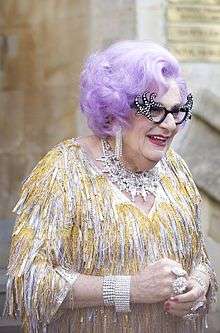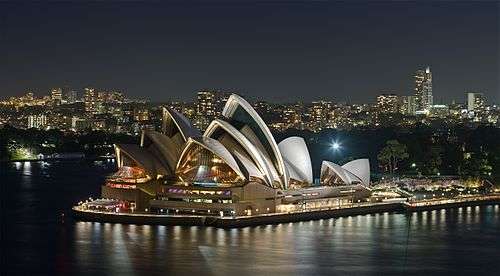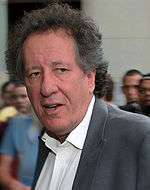Theatre of Australia
Theatre of Australia refers to the history of the performing arts in Australia, or produced by Australians. There are theatrical and dramatic aspects to a number of Indigenous Australian ceremonies such as the corroboree, and fusions of this ancient theatrical content and style with Western theatrical productions are not uncommon in Australia. However, during its early Western history, Australia was a collection of British colonies in which the theatrical arts were generally linked to the broader traditions of English literature and to British and Irish theatre. Australian literature and theatrical artists (including Aboriginal as well as Anglo-Celtic and multicultural migrant Australians) have, since 1788, introduced the culture of Australia and the character of a new continent to the world stage.
A large number of individuals have made a contribution to Australian theatre, many of whom have also been recognised at an international level, including Sir Robert Helpmann (ballet), Dame Joan Sutherland (opera), the performing artist Barry Humphries and playwright David Williamson. Notable theatrical institutions include the Sydney Opera House, and the National Institute of Dramatic Art in Sydney, whose alumni include noted performers and directors Cate Blanchett, Geoffrey Rush, Judy Davis, Jim Sharman and Baz Luhrmann.
History
Early history

The ceremonial dances of indigenous Australians comprise theatrical aspects and have been performed at corroborees since time immemorial (most scholars believe Aboriginal Australians arrived between 40,000 and 60,000 years ago). At a corroboree Aborigines interact with the Dreamtime through dance, music and costume and many ceremonies act out events from the Dreamtime.[1]
European theatrical traditions came to Australia with European settlement commencing in 1788 with the First Fleet. The first production, The Recruiting Officer written by George Farquhar in 1706, was performed in 1789 by convicts.[2] The extraordinary circumstances of the foundation of Australian theatre was recounted in the 1988 play Our Country's Good by Timberlake Wertenbaker - the participants were prisoners watched by sadistic guards and the leading lady was under threat of the death penalty. The play is based on Thomas Keneally's novel The Playmaker.[2]
Post-federation


After federation in 1901, theatre productions embodied the sense of national identity that had tormented in Australian literature since the 1890s. On Our Selection (1912)[3] by Steele Rudd told of the adventures of a pioneer farming family and became immensely popular and was adopted to film.
During the 1940s, John Antill composed the music for his Corroboree ballet based on the Aboriginal corroboree. The production was first performed in 1946 and toured Australia during the 1950s and featured on the schedule of Queen Elizabeth II's first Royal Tour of Australia in 1954. It represents an early example of the fusion of Western and Aboriginal theatrical forms in Australia – now regularly expressed, as seen in the work of the Bangarra Dance Theatre.[4][5]
In early 1955, the Union Theatre Repertory Company invited a young Barry Humphries to tour Victoria with a production of Twelfth Night directed by Ray Lawler. On tour, Humphries gradually invented the character of Edna Everage as part of the entertainment for the actors during commutes between country towns, imitating the Country Women's Association representatives who welcomed the troupe in each town.[6] By night Lawler worked on a new play, Summer of the Seventeenth Doll, his tenth but most acclaimed work. Both creations represented historic milestones in Australian theatre. Summer of the Seventeenth Doll was the first Australian play produced by the MTC and portrayed resolutely Australian characters and went on to international acclaim. At Lawler's suggestion, Mrs Everage made her first appearance in a Melbourne University's UTRC revue at the end of 1955, as the city prepared for the 1956 Summer Olympic Games. The sketch involved a houseproud "average housewife" offering her Moonee Ponds home as an Olympic billet.[7] Humphries left for London in his early 20s and enjoyed success on stage, including in Lionel Bart's musical, Oliver!. His satirical stage creations – notably Dame Edna and later Les Patterson – became Australian cultural icons. Humphries also achieved success in the USA with tours on Broadway and television appearances and has remained a stalwart of British and Australian theatre and been honoured in both nations.[8]
Growth of not-for-profit theatre with public subsidy
The Melbourne Theatre Company, originally the Union Theatre Repertory Company, formed in 1953, is Australia's oldest professional theatre company. Over the years, MTC has championed Australian writing, introducing the works of writers such as Alan Seymour, Vance Palmer, Patrick White, Alan Hopgood, Alexander Buzo, David Williamson, John Romeril, Jim McNeil, Alma De Groen, John Powers, Matt Cameron, Ron Elisha, Justin Fleming, Janis Bolodis, Hannie Rayson, Louis Nowra, Michael Gurr, Jack Davis, Michael Gow and Joanna Murray-Smith and many others to mainstream Melbourne audiences.
The National Institute of Dramatic Art was established in Sydney in 1958. This institute has since produced a list of famous alumni including Cate Blanchett, Toni Collette, Mel Gibson and Baz Luhrmann.[9]
The Australian Ballet was founded by the English ballerina Dame Peggy van Praagh in 1962. It is Australia's foremost classical ballet company and is today recognised as one of the world's major international ballet companies.[10] It is based in Melbourne and performs works from the classical repertoire as well as contemporary works by major Australian and international choreographers. As of 2010, it was presenting approximately 200 performances in cities and regional areas around Australia each year as well as international tours. Regular venues include: the Melbourne Arts Centre, Sydney Opera House, Sydney Theatre, Adelaide Festival Centre and Queensland Performing Arts Centre.[11]
From the 1960s, major cities across Australia developed new government-owned performing arts centres, often housing not-for-profit theatre, opera and dance companies. Examples include the Canberra Theatre Centre, the Sydney Opera House, Arts Centre Melbourne, the Adelaide Festival Centre and the Queensland Performing Arts Centre in Brisbane. Most major regional centres also include a professional-standard performing arts centre, either newly built such as the Wagga Wagga Civic Theatre or the Frankston Arts Centre, or a refurbishment of a heritage theatre or cinema such as the Newcastle Civic Theatre, the Theatre Royal, Hobart or the Empire Theatre, Toowoomba.
With the completion of the Adelaide Festival Centre in 1973, Sir Robert Helpmann became director of the Adelaide Festival of Arts.[12][13]
The new wave of Australian theatre debuted in the 1970s with the works of writers including David Williamson, Barry Oakley and Jack Hibberd. The Belvoir St Theatre established by John Bell and Richard Wherrett originated in Sydney around 1970 and presented works by Nick Enright and David Williamson.
The Sydney Theatre Company was founded in 1978 becoming one of Australia's foremost theatre companies. Players associated with the company include Mel Gibson, Judy Davis, Hugo Weaving, Geoffrey Rush and Toni Collette. Kip Williams is the current interim artistic directors of the Company following the resignation of Jonathan Church. It operates from The Wharf Theatre near The Rocks, as well as the Sydney Theatre and the Sydney Opera House Drama Theatre.[14]
In 1979, two impoverished young Sydney actors, Mel Gibson and Geoffrey Rush, shared a flat and co-starred in a local production of Waiting for Godot.[15] Gibson had studied at NIDA and made his stage debut alongside classmate Judy Davis in a 1976 production of Romeo and Juliet. The 1979 Australian film Mad Max carried Gibson to the beginnings of a global film career.[16] Rush joined Jim Sharman's Lighthouse Theatre troupe in the 1980s and built a reputation as one of Australia's leading stage actors before winning the best actor Oscar for Shine in 1997.
The Bell Shakespeare Company was created in 1990 by John Bell. The company specialises in the works of William Shakespeare. It is Australia's only national touring theatre company touring each Australian state in each year.[17] A period of success for Australian musical theatre came in the 1990s with the debut of musical biographies of Australian music singers Peter Allen (The Boy From Oz in 1998) and Johnny O'Keefe (Shout! The Legend of The Wild One).
In The One Day of the Year Alan Seymour studied the paradoxical nature of the ANZAC Day commemoration by Australians of the defeat of the Battle of Gallipoli.
Ngapartji Ngapartji, by Scott Rankin and Trevor Jamieson, recounts the story of the effects on the Pitjantjatjara people of nuclear testing in the Western Desert during the Cold War. It is an example of the contemporary fusion of traditions of drama in Australia with Pitjantjatjara actors being supported by a multicultural cast of Greek, Afghan, Japanese and New Zealand heritage.[18]
Eminent contemporary Australian playwrights include David Williamson, Alan Seymour, the late Nick Enright and Justin Fleming.[19]
Theatre today
There are a number of publishers of Australian playscripts. Publishers include the non-profit Australian Script Centre, the well-known Currency Press, Playlab Press and Full Dress Publishing. The Australian government supports a website (australianplays.org ) that aims to combine playwright biographies and script information. Scripts are also available there.
There are a range of amateur and professional theatre groups throughout the country, as well as a vibrant independent and fringe theatre community, largely concentrated in Melbourne, home of La Mama.
Theatres
The Theatre Royal, Hobart opened in 1837 and remains the oldest theatre in Australia.[20] Many international performances have appeared at the venue. Noël Coward called it a Dream Theatre and Laurence Olivier came to its defence when it was threatened with demolition in the 1940s.[20]
The Melbourne Athenaeum was founded in 1839 as the Melbourne Mechanics' Institute. It served as a library, school of arts and dance hall and became Australia's first cinema, screening The Story of the Kelly Gang, the world's first feature film in 1906. Mark Twain, Nellie Melba, Laurence Olivier and Barry Humphries have all performed on its stage. The theatre in its present form was created in 1921.[21] The Queen's Theatre, Adelaide opened with Shakespeare in 1841 and is today the oldest theatre on the mainland.[22]
The Australian gold rushes beginning in the 1850s provided funds for the construction of grand theatres in the Victorian style. A theatre was built on the present site of Melbourne's Princess Theatre in 1854. The present building now hosts major international productions as well as live performance events such as the Melbourne International Comedy Festival.[23]
His Majesty's Theatre, Perth opened in 1904. The building remains a rare example of Edwardian theatrical architecture in Australia.[24] Sydney's grand Capitol Theatre opened in 1928 and after restoration remains one of the nation's finest auditoriums.[25] The State Theatre (renamed the Forum in 1963) and the Regent Theatre both opened in Melbourne in 1929.
The Melbourne Arts Centre in the Melbourne Arts Precinct was designed by architect Sir Roy Grounds, the masterplan for the complex was approved in 1960, and construction of the Arts Centre began in 1973. The complex opened in stages, with Hamer Hall opening in 1982, and the Theatres Building opening in 1984. The centre now hosts regular performances by Opera Australia, The Australian Ballet, the Melbourne Theatre Company and Melbourne Symphony Orchestra as well as a large number of Australian and international performances and production companies.[26]
The Belvoir St Theatre was established by John Bell and Richard Wherrett in Sydney around 1970. Construction of the Adelaide Festival Centre was completed in 1973. In the same year, the Sydney Opera House was inaugurated in Sydney – becoming among the most famous theatre buildings in the world. Opera Australia made its home in the building and its reputation was enhanced by the presence of the diva Joan Sutherland.
Theatre companies


Professional
- Bell Shakespeare Company
- Back to Back Theatre
- Black Swan Theatre Company
- Brink Productions
- Company B - based at the iconic Belvoir St Theatre in Sydney.
- Griffin Theatre Company
- Kookaburra Musical Theatre
- La Boite Theatre
- La Mama Theatre (Melbourne)
- Malthouse Theatre
- Melbourne Theatre Company
- Northern Rivers Performing Arts (NORPA)
- Playbox Theatre Company
- Queensland Theatre - the oldest continuous professional theatre company in Queensland.
- State Theatre Company of South Australia
- Sydney Theatre Company
- Twelfth Night Theatre
- Tropic Sun Theatre Company
- Windmill Performing Arts
- National Institute of Dramatic Arts
Independent
- Barking Spider Visual Theatre
- Black Lung
- Stuck Pigs Squealing
- Theatre in Decay
- Sample Theatre
- Yellow Glass Theatre
- Goulburn Lieder Theatre
- Urban Theatre Projects
- Entertainment Blue Mountains
- Q44 Theatre | Melbourne
Musical theatre
- Chamber Made
- Hayes Theatre Co
- Harvest Rain Theatre Company
Physical theatre
- Circa Brisbane
- Circus Oz
- Kage Physical Theatre
- OzFrank Brisbane
- Zen Zen Zo Brisbane
Opera companies
- Opera Australia
- Opera Queensland
- State Opera of South Australia
- Victorian Opera
- West Australian Opera
- J. C. Williamson Ltd.
Theatre education

- Aboriginal Centre for the Performing Arts
- National Institute of Dramatic Art - established in Sydney in 1958.
- Ballarat Academy of Performing Arts
- WAAPA
- Victorian College of the Arts
- National Institute of Circus Arts
- Adelaide College of the Arts
- Flinders University Drama Centre
- Australian Institute of Music
- Monash University Performing Arts
- University of Ballarat, Arts Academy
- University of Wollongong, School of Creative Arts
- Tasmanian College of the Arts
- University of Southern Queensland, Performing Arts
- Charles Sturt University (Acting for Stage and Screen)
- CQUniversity's Central Queensland Conservatorium of Music, Mackay
Awards and competitions
- Green Room Awards - for Melbourne theatre, opera and dance
- Helpmann Award - national awards for plays, musicals, opera, dance, comedy, cabaret, contemporary music and classical music
- Mo Awards
- Matilda Awards - for Brisbane theatre
- Sydney Theatre Awards - for Sydney theatre
Performing Arts Publishers
- Australian Script Centre
- Currency Press
- Playlab Press
- Full Dress Publishing
See also
- Australian Elizabethan Theatre Trust
- Ausstage - Gateway to Performing Arts
- Australian comedy
References
- ↑ Australian Indigenous ceremony - song, music and dance Retrieved 3 October 2016
- 1 2 The Recruiting Officer & Our Country's Good, Stantonbury Campus Theatre Company in November 2000
- ↑ http://www.sclqld.org.au/schp/exhibitions/rudd/directions/default.htm
- ↑ http://www.australiadancing.org/subjects/241.html
- ↑ http://www.bangarra.com.au/About/Vision.aspx
- ↑ Humphries, Barry (1992). More Please. Viking. pp. 176–177.
- ↑ http://www.theaustralian.com.au/news/arts/the-clown-prince-of-suburbia/story-e6frg8n6-1111118780314
- ↑ http://news.bbc.co.uk/2/hi/entertainment/6757531.stm
- ↑ http://www.nida.edu.au/default.aspx?FolderID=15
- ↑ http://www.australianballet.com.au/about_us/history
- ↑ http://www.australianballet.com.au/about_us
- ↑ http://www.adelaidefestivalcentre.com.au/afc/history.php
- ↑ http://www.helpmannawards.com.au/default.aspx?s=sir_robert_helpmann
- ↑ http://www.sydneytheatre.com.au/about
- ↑ http://news.bbc.co.uk/2/hi/entertainment/1202812.stm
- ↑ http://movies.yahoo.com/movie/contributor/1800019113/bio
- ↑ Bell, John (2004). John Bell : the time of my life. Sydney: Currency Press. ISBN 1-74114-134-6.
- ↑ http://www.dailytelegraph.com.au/news/review-ngapartji-ngapartji/story-e6frev39-1111115327660
- ↑ http://australianplays.org/script_search
- 1 2 http://www.theatreroyal.com.au/history.html
- ↑ http://www.melbourneathenaeum.org.au/content/view/20/37/
- ↑ http://www.history.sa.gov.au/queens/about.htm
- ↑ http://www.marrinertheatres.com.au/venue_princess.jsp
- ↑ http://www.hismajestystheatre.com.au/default.aspx?MenuID=41
- ↑ http://www.capitoltheatre.com.au/explore.htm
- ↑ http://www.theartscentre.com.au/about-us/our-story.aspx
External links
- AustralianPlays.org - The largest source of Australian playscripts
- The History of Theatre in Australia
- AussieTheatre.com - Australia's number one theatre news site
- Highlights in Australian theatre history at the Australian Culture and Recreation Portal
- RealTime - Australian contemporary arts magazine covering dance, performance, sound/music, visual arts, film and media art
- AusStage, Australian Performing Arts Database, Flinders University, SA
- AusStage, theatre productions, Australian National Identity 1829 - 2012. -database, Flinders University, SA



